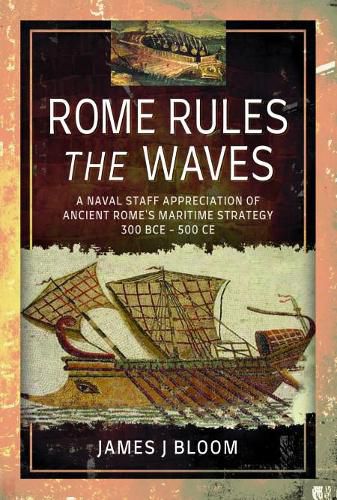Readings Newsletter
Become a Readings Member to make your shopping experience even easier.
Sign in or sign up for free!
You’re not far away from qualifying for FREE standard shipping within Australia
You’ve qualified for FREE standard shipping within Australia
The cart is loading…






The commonly-held view of Rome’s naval history is that it essentially ended with the defeat of Antony and Cleopatra’s fleet at Actium in 31 BC, which left Rome with no rivals at sea just as the Republican period gave to the Empire. There were no more big naval battles so, this view would have it, Rome’s navy was scarcely needed and its role was of little significance to the strategy of the Empire. James J Bloom rams this point of view below the waterline in his reappraisal of the crucial role of the Roman imperial navy. The author (following the line of preeminent naval theoreticians, Alfred Mahan and Sir Julian Corbett) takes the view that sea power is not merely about naval engagements. In its deeper sense, sea power is the steadfast exertion of command of the sea lanes to project trade, suppress piracy, transport troops and supplies and protect land-based military garrisons and expeditions. In effect, this book is a grand-strategical survey of Roman naval power as an instrument to support Roman imperial policy. In contrast to other works on the subject, Bloom argues that modern naval strategic theory can be usefully applied to Roman naval operations. The geography of their empire determined that the Romans would move most of their military supplies by water. During both the Republican and Imperial periods, nearly all of the provinces had extensive coasts alongside the Mediterranean, the Black Sea or the Atlantic Ocean. These interconnected seaways gave the Romans a distinct advantage over their adversaries around the perimeter, who generally had to utilize coasts adjacent to or interdicted by Roman maritime control. As Roman land power threaded along the Black Sea and Atlantic shorelines, major river and estuarine systems became a significant component of this web of vital waterways. Amphibious reach was an essential element of Roman sea power in guarding the wet flanks of the legions and ferrying troops to threatened choke points. Appendices will include scale drawings of the various ship types discussed in the text with their characteristics displayed in tabular form, several maps illustrating the maritime factors of the empire, and a resume of maritime exploration and discoveries in Roman times. AUTHOR: James J Bloom has written extensively on a wide range of military subjects. He is the author of two books (The Roman-Judaean War, 66-73 AD: A MILITARY ANALYSIS (Saga Publications, Rochester, NY, 2002); Jerusalem Against Rome: The Jewish Revolts 66 BC-AD 135 (McFarland Publishing, 2010)) and has contributed to numerus edited volumes, magazines and journals. He lives in Maryland, USA.
$9.00 standard shipping within Australia
FREE standard shipping within Australia for orders over $100.00
Express & International shipping calculated at checkout
The commonly-held view of Rome’s naval history is that it essentially ended with the defeat of Antony and Cleopatra’s fleet at Actium in 31 BC, which left Rome with no rivals at sea just as the Republican period gave to the Empire. There were no more big naval battles so, this view would have it, Rome’s navy was scarcely needed and its role was of little significance to the strategy of the Empire. James J Bloom rams this point of view below the waterline in his reappraisal of the crucial role of the Roman imperial navy. The author (following the line of preeminent naval theoreticians, Alfred Mahan and Sir Julian Corbett) takes the view that sea power is not merely about naval engagements. In its deeper sense, sea power is the steadfast exertion of command of the sea lanes to project trade, suppress piracy, transport troops and supplies and protect land-based military garrisons and expeditions. In effect, this book is a grand-strategical survey of Roman naval power as an instrument to support Roman imperial policy. In contrast to other works on the subject, Bloom argues that modern naval strategic theory can be usefully applied to Roman naval operations. The geography of their empire determined that the Romans would move most of their military supplies by water. During both the Republican and Imperial periods, nearly all of the provinces had extensive coasts alongside the Mediterranean, the Black Sea or the Atlantic Ocean. These interconnected seaways gave the Romans a distinct advantage over their adversaries around the perimeter, who generally had to utilize coasts adjacent to or interdicted by Roman maritime control. As Roman land power threaded along the Black Sea and Atlantic shorelines, major river and estuarine systems became a significant component of this web of vital waterways. Amphibious reach was an essential element of Roman sea power in guarding the wet flanks of the legions and ferrying troops to threatened choke points. Appendices will include scale drawings of the various ship types discussed in the text with their characteristics displayed in tabular form, several maps illustrating the maritime factors of the empire, and a resume of maritime exploration and discoveries in Roman times. AUTHOR: James J Bloom has written extensively on a wide range of military subjects. He is the author of two books (The Roman-Judaean War, 66-73 AD: A MILITARY ANALYSIS (Saga Publications, Rochester, NY, 2002); Jerusalem Against Rome: The Jewish Revolts 66 BC-AD 135 (McFarland Publishing, 2010)) and has contributed to numerus edited volumes, magazines and journals. He lives in Maryland, USA.